While solar wind is pouring through a crack in Earth’s magnetosphere, G2-class storms and bright auroras spark around the Arctic Circle.
But not only. Some made their way all the way down to Canada and the Virginias where awesome blood red auroras lit up the skies.

Geomagnetic storms are underway on Sept. 9th. And the night skies fill up with northern lights from the Arctic Circle and down up to the Virginias.
In Virginia, the sky was colored by a cherry red glow:
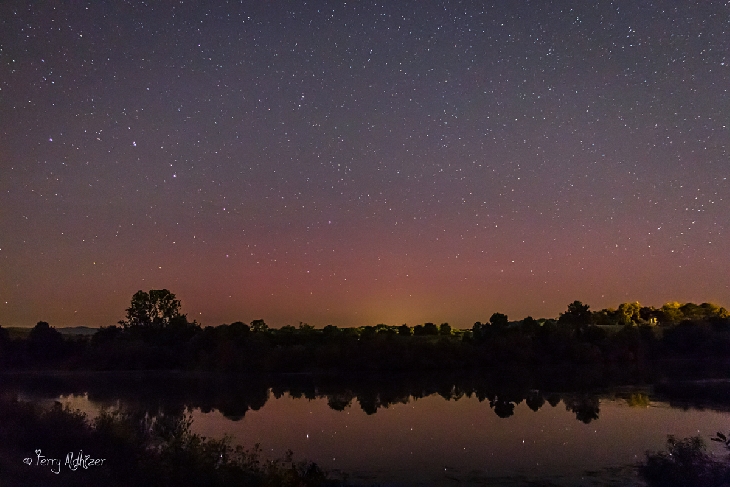
Red auroras still baffle scientists. According to SpaceWeather:
“[…]They occur some 300 to 500 km above Earth’s surface, much higher than ordinary green auroras. Some researchers believe the red lights are linked to low energy electrons from the sun, which move too slowly to penetrate deeply into the atmosphere. When such electrons recombine with oxygen ions in the upper atmosphere, red photons are emitted. At present, space weather forecasters cannot predict when this will occur […]”
In Montana, the usual green auroras mixed with purple, blue and red:
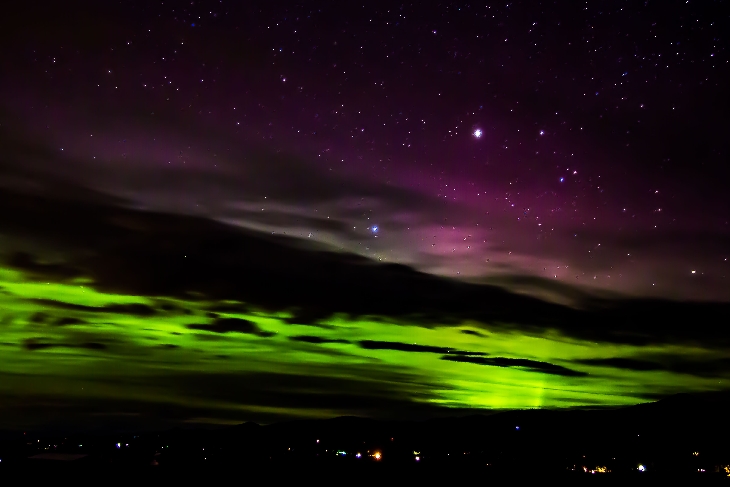
And here red and green northern lights one on top of the other in Keller, Washington:
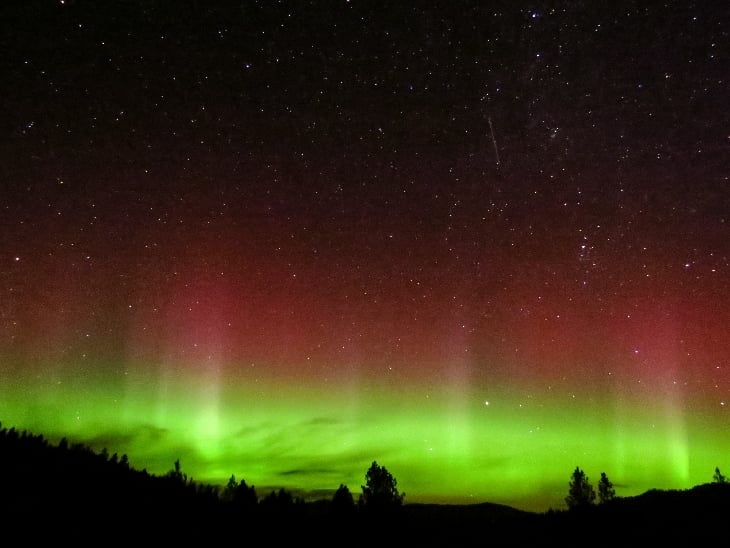
And here again red over green auroras in Ault, Colorado:

Red auroras but most probably green northern lights may appear also in the sky tonight as the solar wind continues to blow. Keep you eyes up.




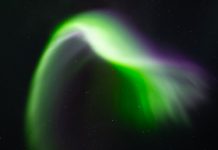
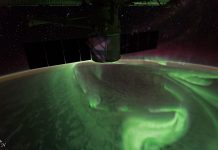
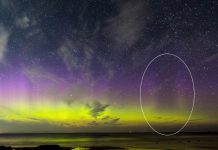

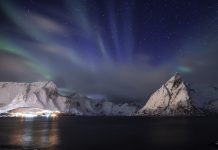
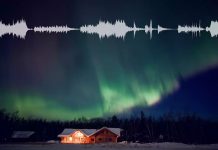
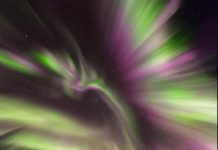

[…] auroras’ bright spots and columns of various hues appearing in the sky are produced by solar […]
When the ionosphere is not being energized near peak levels from the relatively constant influx of solar wind produced during highly-active solar phases, the ionosphere weakens. We are possibly seeing positive charge components of cosmic rays energizing upper atmospheric noble gasses, if not witnessing the inverse polarity effect from ordinary auroras interacting with strong mixed influx of high-energy particles on a positively-charged region of the ionosphere, which is unusual, but is associated with a spike in powerful positive cloud-ground lightning dominating the visible atmospheric electrical regime in late summer-early autumn in the same latitude zone that can view these auroras and beyond, also associated with the mid-range phase of the transition between solstices, in terms of Northern hemispheric insolation. I would ask whether there has been a recent tendency for emergent large-scale ground inversion of telluric current linked to climate system-coupled geodynamic-solar geomagnetic variations, or due to warm, typical late summer differentially-dry sediments inducing a net negative charge gain at the front of percolating and saturating groundwater in the direction and preceding the maximum precipitation peak, in terms of attraction and generation of ground strikes. These strikes are often difficult to distinguish by large area lightning flash detection arrays between other large negative strikes, and their actual power cannot be determined through these methods, except by their relative detection strength between receivers in rather disparate places – especially where Earth curvature has a filtering effect on signal strength – that detect upper atmospheric field disruptions. Sprite detection networks detect high-energy ground strikes by implication, synchronized to clocked detected ground flashes. Compare to the difference in how gasses are ionized and exhibit photoemission in sprites and other TLE events during powerful thunderstorms (often mistaken for UFOs); their polarity is generally positive, and produce red filaments and halos [“elves”], but when the ground-directed strikes that produce the sprite event in opposing correspondence is negatively-charged, their upward return strokes can induce upward charge/ion propagation and trigger upward negative discharges, and when these are directed at the ionosphere, are visible as green sprites (compare to typical green auroras.
There are some very powerful storms at work right now. Their activity does interact with the ionosphere, and, conversely, it has been hypothesized that cosmic rays can both nucleate could formation by ionizing aerosols and also trigger powerful ground strikes by causing a relativistic electron (or positron) cascade that attracts ions and further electrons and positrons, accelerating ions and generating further charge through many possible dynamic routes, including an increase in magnetic field strength through a conventional Hall effect due to transverse discharges or possibly a relativistic quantum Hall effect that operates locally, contributing to the development of charge separation, streamer formation/symmetry breaking in fields, and structures within clouds that may provide even greater homogeneous capacitance.
The increase of cosmic ray neutron detection rates and an increase of ground strikes has been highly correlated in time series, statistically, in several studies. Electron-positron generation of gamma rays and electron-ion collision-generated X-rays, with at least some fast neutron generation, have all been detected preceding strikes and in bursts accompanying strikes and TLE events. It is still unknown whether secondary gamma ray bursts or fast neutron production accompany the lightning leader column-streamer/ground node attachment moment, which may actually contribute to the abundance of certain cosmogenic isotopes paradigmatically-relegated to a simple production through ionospheric fast neutron spallation. Perhaps we are seeing an increase in cosmic ray-induced production of boron and radiogenic carbon.
I do not know if it is a new trend. The fact is that these auroras did appear pretty south and some got red, meaning as you say that other atoms are excited than those responsible for the green color (most common). As the red color actually only occurs at higher altitudes than the green counter parts, it may mean that the last geomagnetic storm excited a part of our atmosphere that isn’t normally undergoing changes. The storm wasn’t so intense, so there is really something we don’t understand behind the formation of these weird red northern lights.
[…] Website: Strange Sounds.com Dated: Sept. 9 , 2015 Credit: Strange Sounds.com Image credits:: Blood red auroras in the sky of Spruce Knob, West Virginia. Photo by Darren Shank This cherry red aurora was photographed by Terry Aldhizer over Botetourt County Virginia Green and purple aurora over Hamilton, Montana. Photo by Mike Daniels Green auroras superimposed with red northern lights in Keller, Washington. Photo by Rocky Raybell Awesome aurora display in Ault, Colorado photographed by Paul Robinson Link: http://strangesounds.org/2015/09/myst… […]
Can 4 years of blasting radiation in all directions from Fukushima make a hole in the sky?